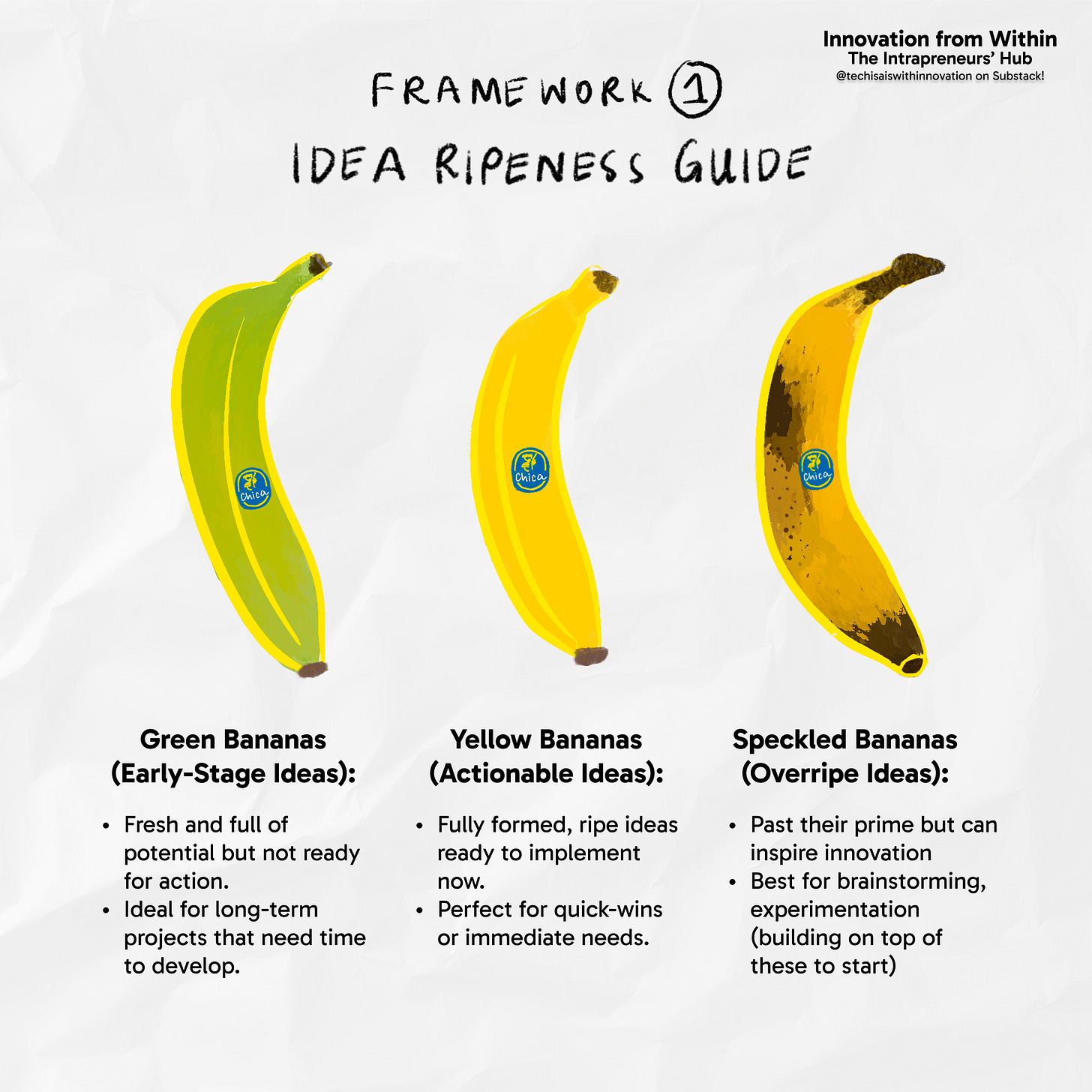The Chiquita Method: How to Spot and Prioritize Winning Ideas
From bananas to ideas: A guide for idea-choosing and prioritizing with a simple, no-brainer framework - The Chiquita Method (by Francisca)
Happy Wednesday, folks! Can mid-week get sweeter? It just might after you read this post!
Let’s start with a scene we’ve all lived through: rushing through the supermarket aisles, shopping list in hand, juggling a mental to-do list that’s already two pages long and then you hit the fruit section, before you proceed with the rest of the shopping.
Now you’re standing in front of the banana shelf, and suddenly, your focus narrows. How do you pick the right bananas? Maybe you’re meal-prepping for the week, so you reach for the green ones that will ripen slowly. Or perhaps you’re about to bake a legendary banana bread, so you go for the soft, spotty ones that are bursting with sweetness.

Luckily, banana picking is something we’re used to doing, and we don’t need to overthink it. We rely on the bananas’ appearance, color, and sometimes a quick touch to make our decision.
Today, I’m introducing you to what I lovingly call the Chiquita Method. No, not the iconic banana brand, this is my playful spin on the nickname "Chiquita," a pet name derived from my name, Francisca (or Chica). Almost nobody calls me Chiquita, but for the sake of this not-SEO-optimized article title, let’s stick with it.
The Chiquita Method is a straightforward approach to idea prioritization, that I’ve developed in the past few months, after having an idea for it while having a snack.
The problem it tries to solve is that: how can we all be innovating if we get caught up needing to know so many frameworks?
Not anymore! Whether you’re a Substack writer, a team member in a fast-paced workplace, or anybody trying to understand how to proceed with prioritizing ideas, this method makes that process as simple as shopping for fruit - no need to train or look for difficult frameworks, if you don’t do this everyday!
“When should I be prioritizing ideas?” You might ask…
I’m assuming you already did some type of brainstorming or ideation session, either by yourself or with a team, which, might look a bit like the image below.
Psst: Last week, we had a brainstorming and creative thinking techniques session, so if you’d like more actionable tips and a 1h masterclass on idea generation and how to set up the space and techniques to use, contact me or reply to this e-mail and I’ll share the slides & recording with you!
Now, we get to a stage of categorization and prioritization.
Easier said then done, sometimes. So, how might we make this simpler? First, break all the post-its of ideas down in categories of themes (for instance, compare apples with apples and bananas with bananas).
On prioritization: Each post-it/idea has its moment of ripeness, and it’s up to us to decide whether it’s ready to shine now or needs a little more time to develop.
Some are bright and fresh, full of potential but not quite ready for action, like green bananas.
Others are perfect for immediate use, ripe and yellow, ready to fuel your next big step.
Then there are the overripe ones, the speckled bananas, which might seem past their prime but can surprise you with creative possibilities, like a batch of warm banana bread straight out of the oven… or, if you wait too much, they’ll just rot and might even spoil the rest of the fruit basket (and bring in fruit flies). We don’t want that… so: let’s break it down further.
Innovation from Within’s Framework #1: The Idea Ripeness Guide
Step 1: Identify Your "Banana Type"
Every idea falls into one of three categories, much like bananas at different stages:
Green Bananas (Early-Stage): These ideas are fresh and exciting but need more time and nurturing. Think of them as your long-term projects or exploratory concepts.
Yellow Bananas (Actionable): These are your ready-to-go ideas. They’ve ripened, they’re solid, and they’re perfect for immediate execution.
Speckled Bananas (Overripe): These ideas might feel old or overlooked, but they hold hidden value. With a bit of creativity, they can spark innovation in unexpected ways.
Step 2: Match Ideas to Your Goals
Now that you’ve sorted your ideas, pair them with your priorities.
Long-Term Projects: Green bananas are ideal here. Let them ripen while you focus on more pressing tasks.
Examples: ideas that need more than one team working on them, and you can still survive without it being done; for example: an idea that is to redefine the entire way the company looks at a CRM or a financing tool… yeah, that one will be a green banana for a while! Does it make sense for you to prioritize it now?
Quick Wins: Yellow bananas are perfect when you need something actionable right away.
Examples: ideas that are quick to develop, they are low-effort and high-value; ideas that are inspiring the team to work on this new project as it contributes with more time savings
Creative Opportunities: Speckled bananas can be either great or bad for you.
You should revisit these before they spoil - and if they do, don’t bother going after them.
Examples: an idea that made sense before the company shifted values; an idea that made sense when a trend was still… a trend (nobody does flash mobs anymore, so a flash mob as a marketing stunt probably won’t work with today’s crowds…) 1
Step 3: Evaluate Timing and Resources
Just like you wouldn’t buy a week’s worth of bananas without considering when you’ll eat them, don’t overload yourself with ideas that aren’t practical for your current situation.
Ask yourself:
Do I have the resources to act on this idea now?
Will this idea still be relevant in a few weeks or months?
Is there a risk of "idea rot" if I wait too long?
If it already is a rotten idea from the start, leave it be. This might have been something you’ve discussed for the past 5 months and it keeps on coming back. Maybe you’ll need to do a 5 Why’s analysis on what’s going wrong there, something to cover for another time!
So in this case, you are going to use a type of dot voting, but you’re going to be voting with bananas (yes, literally). Every screenshot you’re seeing is the framework in action, and I’m making this a free template for you to use!
In the end, this is what you might be having:
And once you group them based on the votes:
Now, you need to see within the ripe bananas, which one you’re most comfortable with starting, based on efforts, resources, need, and so on.
I can’t really tell you what matters most here, because every team and every company have different values, budgets, needs, problems.
Closing Thoughts: Peel, Pick, Prioritize
The Chiquita Method is about simplicity.
Whether you’re dealing with work projects, personal goals, or even what to write about next, treat your ideas like a basket of bananas. When you have a problem, make it a habit to revisit the “fruit basket” before you go shopping (in this case: check if you already had ideas you didn’t start yet, that could solve it, before going full-brainstorming mode). You might find something actionable, something applicable to have in development, or something creative to explore.
Why does this work?
Because this makes a difficult process simple. You almost don’t need to explain anybody difficult quadrants or matrixes… Life doesn’t have to be overcomplicated. Neither does prioritizing your ideas need to be!
So, the next time you’re overwhelmed by a flood of possibilities, channel your inner supermarket-goer, grab the idea that fits your current needs, and start building on it.
And to make it even simpler, welcome to my second Miro template you can use on your future brainstormings! I’m going to be improving this one, but you can already get access to a beta version today!
Key Takeaways:
* Balance your idea basket regularly:
> Revisit the Speckled Bananas: Overripe ideas often get overlooked, but they can surprise you. Something you dismissed as "too wild" or "too early" might now fit perfectly with a little tweaking.
> Rotate Your Stock: Like bananas, ideas have a shelf life. Make it a habit to revisit your backlog of ideas and reassess their potential. You might be able to solve your problems faster, instead of always going back to square 0!
* Experiment Freely: Don’t be afraid to use old or "expired" ideas in new contexts. Sometimes, the best breakthroughs come from what you thought had no more value.
* Prioritization comes with:
> understanding what you need to solve,
> knowing what you have as resources (can you make banana bread without eggs and other ingredients? probably not)
> focusing on solving the problem with 1 idea at once
If you’ve got an idea waiting to ripen, don’t toss it aside too quickly. It might just become your delicious banana bread moment. 🍌
Thanks for reading, and here’s a little something extra:
A week from now, on December 3rd, I’m hosting a free session on idea prioritization with Bohdan Yeromenko. It’s going to build on top of this topic presented today, it’s 1h long, and sign-up is as easy as peeling a banana! If you want to see this and other techniques in action make sure to sign up here!
Hope to see you there :)
As I mention above, these are also ideas you can build upon. A technique that calls for this is a “checklist” to follow with an easy to memorize name: SCAMPER. Each letter means something (Substitute, Combine, Adapt, Minimize, etc), and just before I posted this article,
from Sketchy Ideas made a quite sketchy way of portraying this framework! So if you want to learn it in a visual way, here you go:










Life doesn’t have to be overcomplicated - true words. Your Chiquita method simplifies the prioritization process. As I was reading this, I could easily even start sorting through my projects mentally and know which ones were green, yellow or speckled. Thank you Francisca for sharing your framework.
Ah Chiquita, great stuff, almost felt like being back at college with the teacher who was able to put a fun spin on things.
The creative use of bananas is really ripe for illustrating this method.
I have lots of each type of banana so I'm going to go through and rotate, get to the ripe ones before they spoil!